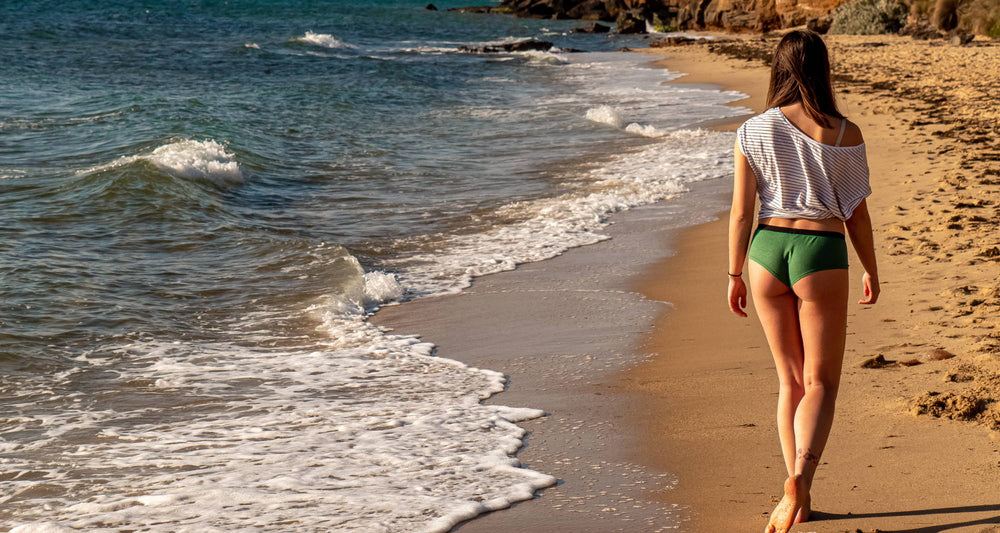
Best UPF Fabric Options for Ultimate Sun Protection
|
If you're not happy with your first pair of underwear after trying it on, let us know.
We'll send a new size or color, or give you a refund. No returns needed.

Katie Lemon
|
While feeling the warm sun on your skin is one of the yummiest sensations we can experience as humans, it’s important to keep our bodies safe from overexposure. That’s why today we’ll be discussing the best fabric for sun protection.
I’ll be going over everything you need to know about UPF fabric, including the many reasons why hemp is the best choice for protecting your skin from harmful UV rays. So if you’re already an enthusiast of hemp clothing brands , you’ve got an advantage!
Whether you’re already sporting your favorite hemp hipster panties or mens boxer briefs each time you go outside or you’ve yet to discover the wonders of hemp, read on to find out all you need to know about UPF 50 fabric and other tips for staying safe in the sun!
The term UPF fabric can define any fabric that helps protect your skin from harmful UVA and UVB rays. UVA rays have a longer wavelength (and long-term effect) and are associated with skin aging while UVB rays have a shorter wavelength (and immediate effect) and are associated with sunburns.
UPF stands for “ultraviolet protection factor” and its rating determines how well a fabric can block harmful sun rays. A higher rating means the fabric is doing a better job of protecting your skin. The Skin Cancer Foundation suggests covering up as much of your skin as you can with fabric with a UPF rating of 50+, meaning less than 2% of UV rays can penetrate it.
Here’s a clear breakdown of how the UPF rating system works:
SPF stands for “sun protection factor” and is most commonly associated with sunscreen. So, you may encounter the term SPF fabric but it’s likely an error when it’s referred to as such. The SPF rating refers to how long it takes skin to redden and works only to protect skin against immediate UVB rays.
Of course, sunscreen is always highly recommended, even if you’re already wearing UPF clothing. It’s likely that you aren’t covering your body head to toe in fabric during sweaty summer days so a combination of both sunscreen and the best fabric for sun protection is the way to go!
We’ll be getting into all the factors that affect a fabric’s UPF rating in a second, but first let’s take a look at the fabrics that do the best job of protecting your skin from the sun! Here are three contenders for the best fabric for sun protection, ranked from least to most effective:
Wool and denim are both mostly natural fabrics and both offer a decent level of sun protection. This study notes that over 70% of wool fabric samples offered a UPF rating of 50+ which makes it seem like a great choice for protecting your skin from the sun.
However, there is a downside. I’m sure you’ve guessed what it is—Neither wool or denim are fabrics one would consider comfortable for summer weather! I don’t know about you but the thought of wearing a pair of jeans in 90-degree weather makes me want to peel my skin off (which kind of defeats the purpose of protecting it in the first place).
You already know that I’m not a fan of synthetic fabrics but I have to give credit where credit is due. Nylon and polyester actually offer an even better degree of sun protection than wool with a 50=UPF rating in over 76% of samples.
Of course, I’m going to encourage you to stick around for our top choice of UPF fabric by mentioning how very not eco-friendly both nylon and polyester are:
All that being said, the best fabric for sun protection is, of course, hemp! It seems like the hemp clothing benefits are endless! It’s a natural fabric, it’s known for its protective qualities against UV rays, and it’s highly breathable which makes it the perfect summer fabric.
Don’t quite believe me? Well, we’ve got proof! Check out these results of a test WAMA had done by a third-party service, SGS testing :
As you can see, hemp tested as 99.9% effective against blocking both UVA and UVB rays. This officially makes it a UPF 50 fabric and the results remained the same for when the fabric was wet. That means you can confidently sweat or swim in your hemp bra or hemp underwear without diminishing the protection your skin is getting.
This and all the other unique qualities of hemp (like its durability and antibacterial properties) allow me to confidently rank it as the best fabric for sun protection!
For full transparency and so that you can see we mean business about protecting your skin and not just promoting our fave fabric, check out the complete report here .
Hemp fabric turned out to be 99.9 percent effective in blocking UVA and UVB rays! This means that hemp is officially 50+ UPF and ranked “excellent” for sun protection. Even better? Results didn’t change when the fabric was wet, which is pretty major. No need to worry about sweat ruining your sun protection, or wearing hemp for a swim and losing all those protective benefits.
For a detailed breakdown of just how awesome hemp is when it comes to UPF, download the full report here .
You mean companies will lie to you in order to sell their products? No way!? I think we are all familiar with the concept of false advertising and the more that people become aware of UPF fabric, the more misinformation starts to spread.
Shop mindfully and make sure that you aren’t being duped into buying clothing that doesn’t have a proven and tested UPF rating, preferably from a non-biased,trusted third-party source. That’s why WAMA strives for full transparency by sharing our test results with you in this post.
As I mentioned in the previous section, the weave of the fabric affects its ability to protect your skin. That means that if your clothing is too tight it will stretch and lengthen the weave of the fabric. A little bit of wiggle room will also allow your body more room to breathe on those super hot days, so if you’re between sizes choose to opt for the larger one.
Unfortunately, not even the clothes with the highest possible UPF rating are as wonderful as hemp. The UPF rating of most other fabric options decreases when the clothes get wet. For that reason, you’ll want to carry a change of clothes with you if you plan on swimming or there’s a chance of brief rain showers. Or save yourself the headache and go with hemp!
Dark colors more effectively absorb the sunlight which can definitely make you feel a little warmer but prevents the sun’s harmful rays from hitting your skin directly. For maximum protection, go for darker colors like black or navy!
Handwashing is a great way to prolong the life of all of your clothes as it’s a much gentler process than throwing them in the machine. This is particularly important for all of your UPF clothing. If you want it to maintain its effectiveness you have to treat it with care!
Covering yourself up in even the best fabric for sun protection isn’t always an option. After all, what’s the point of going to the beach besides soaking up some sun? Here are some other tips for keeping your skin safe while still enjoying the opportunity to get some color and vitamin D:
Now that we all know what the best fabric for sun protection is, I hope we’ll be seeing a lot fewer sunburns and a lot more safe enjoyment of that sweet vitamin D!
Did you know that UPF 50 fabric was a thing or are you like me and thought that all clothing offered the same level of sun protection? Share your thoughts in the comments and let’s all encourage each other to soak up the warm weather without doing our bodies any harm!
Get updates on restocks, new color and size releases, and upcoming product launches. You’ll also get a 15% discount on your first order of hemp underwear.


